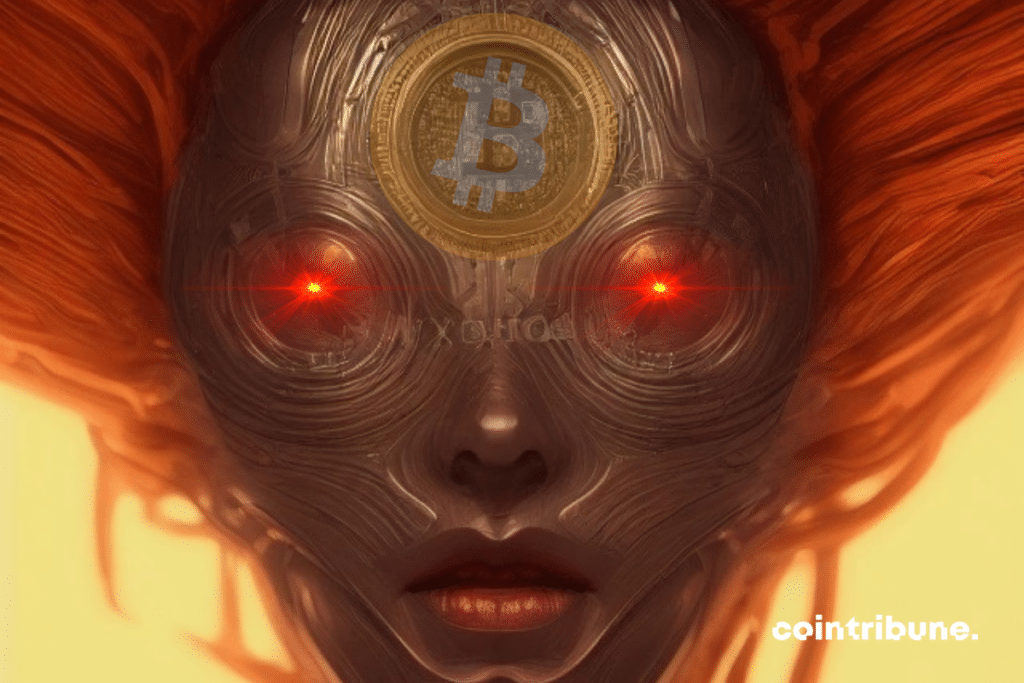Satoshi Nakamoto: Who is the founder of Bitcoin?
In the world of crypto, the name Satoshi Nakamoto remains as intriguing as ever. No one knows who is behind this pseudonym, but his legacy continues to fuel theories, fantasies, and passionate debates. This article revisits the birth of bitcoin, the mysterious disappearance of its creator, and the technological and ideological imprint he left on the entire crypto world. You will also discover the most credible profiles behind the name Satoshi Nakamoto, the extent of his fortune in bitcoins, and how his anonymity strengthened the spirit of decentralization at the heart of the Bitcoin network.

In brief
- Satoshi Nakamoto is a pseudonym whose identity remains unknown.
- He published the whitepaper founding Bitcoin in 2008.
- He publicly disappeared in 2011 to strengthen decentralization.
- Satoshi Nakamoto holds between 750,000 and 1.1 million unmoved bitcoins.
- Several suspects exist, but none have been confirmed.
- He created the proof-of-work secured blockchain.
- Satoshi Nakamoto’s legacy still influences crypto and global finance.
The mysterious identity of Satoshi Nakamoto in the Bitcoin universe
Satoshi Nakamoto is the pseudonym of the person or group behind the Bitcoin protocol. His real identity remains unknown despite numerous investigations and speculations.
The 2008 financial crisis was a significant moment for Bitcoin’s development.
The message embedded in the Bitcoin network’s genesis block – “The Times 03/Jan/2009 Chancellor on brink of second bailout for banks” – reflects a critique of the traditional banking system and a desire to propose a decentralized and censorship-resistant alternative.
The founding whitepaper and Satoshi Nakamoto’s innovation
Bitcoin’s whitepaper, published in 2008 by Satoshi Nakamoto, defines a peer-to-peer electronic payment system without a trusted third party. This theoretical document laid the foundation for a revolutionary protocol solving the double-spending problem without a central authority.
| Date | Event | Contribution |
|---|---|---|
| October 31, 2008 | Whitepaper published | Presentation of Bitcoin’s theoretical architecture |
| January 3, 2009 | Creation of the genesis block | Concrete implementation of the protocol described in the whitepaper |
| January 9, 2009 | First transaction | Sent first block of 50 satoshi to Hal Finney |
| May 2010 | Last public contributions | Transferred development keys to Gavin Andresen |
Analysis of the code developed by Satoshi Nakamoto reveals remarkable technical skill. The Bitcoin Core source code shows advanced skills in cryptography, system programming, and digital economics. Technical choices, such as the use of the SHA-256 algorithm and the blockchain structure, demonstrate rare expertise combining computer security and economic modeling.
The enigmatic disappearance of Satoshi Nakamoto from the crypto world
Satoshi Nakamoto’s last public message dates from April 26, 2011, addressed to Nick Szabo, with whom he was discussing the project. The next day, he told Gavin Andresen he had “moved on” without giving further explanations.
Satoshi Nakamoto’s disappearance has deep implications for Bitcoin network governance. It is speculated that the disappearance of Satoshi Nakamoto hides troubling motives. By remaining anonymous, the creator avoided becoming a central authority figure, thus reinforcing the principle of decentralization. This absence forced the community to establish collegial governance mechanisms to avoid risks of arbitrariness or protocol capture by a single individual.
The fortune and influence of Satoshi Nakamoto in the crypto ecosystem
Analysis of the first mined blocks supports the idea that Satoshi Nakamoto owns between 750,000 and 1.1 million bitcoins.

The current value of these holdings exceeds 116.7 billion dollars.
- The first blocks mined by Satoshi Nakamoto hold about 50 BTC per block, totaling 1.9 million bitcoins;
- The crypto community worries about the potential volatility caused by any movement of this amount of BTC;
- The Bitcoin network’s balance could be disturbed if these bitcoins were suddenly introduced to the market.
The lack of movement of bitcoins attributed to Satoshi Nakamoto strengthens his legend. This unchanged reserve since the network’s creation represents about 5.2% of the total bitcoin supply. Recent movements from old wallets, like the 250 BTC moved in May 2024, trigger speculation without implicating the creator. The stability of these holdings contributes to the perceived scarcity of bitcoin, indirectly influencing its market value.

The philosophical legacy and influence of Satoshi Nakamoto on the blockchain
The technical and philosophical principles established by Satoshi Nakamoto continue to guide crypto development. Decentralization, transparency, and the absence of a central authority are the foundation upon which current blockchain protocols rest.
Today’s bitcoin embodies a complicated evolution compared to Satoshi Nakamoto’s original vision. Initially designed as a peer-to-peer electronic cash system, it has transformed into a digital store of value sought after by institutions.
Institutional adoption of bitcoin, illustrated by companies massively buying BTC, contrasts with the whitepaper’s libertarian ideal. This tension between idealism and pragmatism marks the ecosystem, where technological evolution seeks to balance accessibility and security.
Potential candidates for the title of Satoshi Nakamoto: Critical analysis
Identifying the real Satoshi Nakamoto requires the analysis of technical skills, linguistic footprint, and the history of contributions to the Bitcoin project. Dozens of individuals have been suspected, but only a few have concrete links to the code, cryptography, and exchanges of the time. The absence of irrefutable proof maintains the mystery.
Here is a comparison of the main candidates for the title of Satoshi Nakamoto with their strengths and weaknesses:
| Candidate | Strengths | Weaknesses |
|---|---|---|
| Dorian Nakamoto | Identified by Newsweek in 2014 for his libertarian beliefs, Japanese heritage, and career in defense projects. A fund of 102.23 bitcoins ($34,500 in 2014) was created in his name. | He categorically denied involvement, claiming to have misunderstood the questions. No technical evidence or correspondence with Bitcoin’s code. The community remains skeptical. |
| Craig Wright | Claims to be Satoshi in 2015, supported by technical documents and degrees (masters in statistics, two PhDs). Gavin Andresen initially believed in his authenticity. | Evidence falsified (backdated encryption keys, inconsistencies). Vitalik Buterin called him a fraud. In 2024, the High Court of London rejected his claim. |
| Nick Szabo | Creator of the precursor concept Bit Gold (1996), one of the predecessors of Bitcoin. Expert in smart contracts and cryptography. Stylometry (linguistic study) links his writing to Satoshi’s texts. | He has always denied being Satoshi. Although his ideas inspired Bitcoin, no material proof connects his work to the blockchain. |
| Peter Todd | Accused in the HBO documentary Money Electric (2024) for his expertise in applied cryptography and early involvement in crypto development. | He denied the allegations. No concrete evidence links him to Satoshi’s correspondence or code. |
| Adam Back | Co-author cited in the Bitcoin whitepaper. Inventor of the proof-of-work algorithm (Hashcash) and co-founder of Blockstream. | Denied being Satoshi. His technical profile is credible, but no material evidence supports his candidacy. |
| Len Sassaman | Evan Leung’s theory (2021): key developer in e-cash (DigiCash) and close to David Chaum, an inspiration for Satoshi. | Died in 2011, before the Bitcoin network launch. His widow, Meredith Patterson, ruled out that he created Bitcoin. |
Since 2015, Australian computer scientist Craig Wright is the only person to have publicly claimed to be Satoshi Nakamoto. But his attempts to prove this identity have faced many criticisms: documents deemed forged, technical inconsistencies, and expertise considered insufficient by the developers of the Bitcoin project. In 2024, the High Court of London ruled: Wright is not the creator of Bitcoin.
The technical and philosophical legacy of Satoshi Nakamoto for the future
Satoshi Nakamoto introduced major advances in cryptography with the proof-of-work system and the solution to the double-spending problem through an immutable blockchain.
The Bitcoin blockchain architecture is based on a hash-linked chain of blocks, secured by proof-of-work. This model has inspired many decentralized protocols, although alternatives like proof-of-stake have emerged to address scalability and energy efficiency challenges.
Satoshi Nakamoto’s economic vision and bitcoin as an alternative

Satoshi Nakamoto’s economic vision was based on decentralization and supply limitation to counter inflation, a legacy of the anarchist Cypherpunks movement. This vision manifests through several fundamental pillars that redefine the rules of the traditional monetary system:
- Radical decentralization: Bitcoin eliminates any central authority by transferring trust from institutions to a peer-to-peer network, thus fulfilling the cypherpunks’ prophecy of a government-free currency;
- Programmable scarcity: The 21 million unit limit and the halving mechanism create an anti-inflationary digital currency, defying central banks’ expansionist monetary policies;
- Cryptographic transparency: The public blockchain allows full auditability of transactions, coupled with advanced cryptography to protect users’ anonymity while guaranteeing the integrity of the Bitcoin system;
- Resistance to intermediaries: By rejecting trusted third parties like banks and notaries, Bitcoin establishes a digital social contract where algorithms replace traditional institutions in validating exchanges.
Satoshi Nakamoto’s economic vision, founded on programmable scarcity and radical decentralization, has materialized today into a globally recognized investment asset. However, the evolution toward institutional adoption and persistent volatility distance bitcoin from its initial ideal as an everyday medium of exchange. This duality between a store of value and a means of payment reflects tensions between technical idealism and economic pragmatism. While the mystery surrounding the identity of Satoshi Nakamoto, the bitcoin creator, persists, his technological legacy and economic philosophy continue to shape the crypto ecosystem. The resilience of the Bitcoin network against any centralization embodies the vision of a free monetary system, inviting a reinterpretation of the foundations of digital trust in a world seeking alternatives.
FAQ
In 2012, Satoshi Nakamoto claimed to have been born on April 5, 1975, which would make him 49 years old today. However, his identity remains unknown, making this information uncertain. Linguistic clues suggest he may not be Japanese, but rather from an English-speaking Commonwealth country.
There is no way to contact Satoshi Nakamoto directly, as his true identity remains unknown and he has not been active in Bitcoin development since 2010. Online searches provide no information that could lead to the person or group behind the pseudonym. Some entities use the name “Satoshi Nakamoto” for commercial or informational purposes, but they are not the original creator of Bitcoin.
Satoshi’s anonymity reinforces Bitcoin’s “trustless” nature, where users don’t need to rely on any single entity or authority. It also helped foster a diverse community around the network, allowing people from various backgrounds to contribute to the development and growth of the ecosystem.
Several extravagant theories circulate about the identity of Satoshi Nakamoto, the creator of Bitcoin. Some claim that Satoshi is actually a group of individuals hiding behind a single name, or that the name itself is a cryptographic code. Bolder theories suggest that Elon Musk could be Satoshi Nakamoto, or that the NSA (National Security Agency) created Bitcoin due to its expertise in cryptography.
Maximize your Cointribune experience with our "Read to Earn" program! For every article you read, earn points and access exclusive rewards. Sign up now and start earning benefits.
The Cointribune editorial team unites its voices to address topics related to cryptocurrencies, investment, the metaverse, and NFTs, while striving to answer your questions as best as possible.
The views, thoughts, and opinions expressed in this article belong solely to the author, and should not be taken as investment advice. Do your own research before taking any investment decisions.